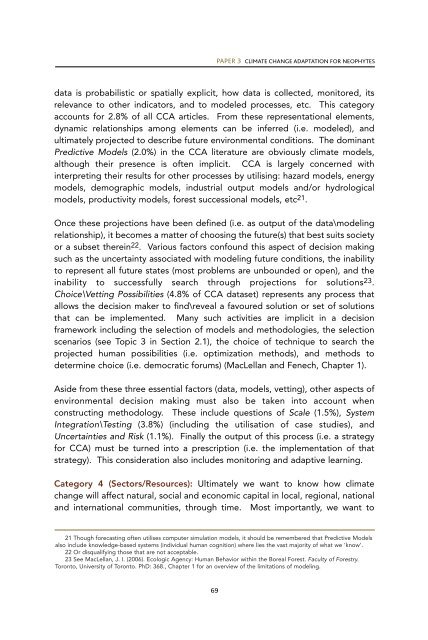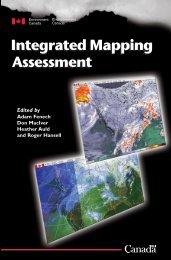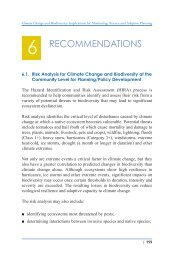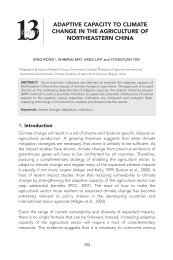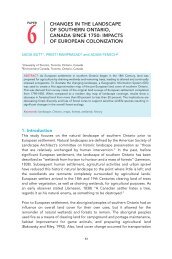Paper 3: Climate Change Adaptation for Neophytes - UPEI Projects
Paper 3: Climate Change Adaptation for Neophytes - UPEI Projects
Paper 3: Climate Change Adaptation for Neophytes - UPEI Projects
You also want an ePaper? Increase the reach of your titles
YUMPU automatically turns print PDFs into web optimized ePapers that Google loves.
PAPER 3 CLIMATE CHANGE ADAPTATION FOR NEOPHYTESdata is probabilistic or spatially explicit, how data is collected, monitored, itsrelevance to other indicators, and to modeled processes, etc. This categoryaccounts <strong>for</strong> 2.8% of all CCA articles. From these representational elements,dynamic relationships among elements can be inferred (i.e. modeled), andultimately projected to describe future environmental conditions. The dominantPredictive Models (2.0%) in the CCA literature are obviously climate models,although their presence is often implicit. CCA is largely concerned withinterpreting their results <strong>for</strong> other processes by utilising: hazard models, energymodels, demographic models, industrial output models and/or hydrologicalmodels, productivity models, <strong>for</strong>est successional models, etc 21 .Once these projections have been defined (i.e. as output of the data\modelingrelationship), it becomes a matter of choosing the future(s) that best suits societyor a subset therein 22 . Various factors confound this aspect of decision makingsuch as the uncertainty associated with modeling future conditions, the inabilityto represent all future states (most problems are unbounded or open), and theinability to successfully search through projections <strong>for</strong> solutions 23 .Choice\Vetting Possibilities (4.8% of CCA dataset) represents any process thatallows the decision maker to find\reveal a favoured solution or set of solutionsthat can be implemented. Many such activities are implicit in a decisionframework including the selection of models and methodologies, the selectionscenarios (see Topic 3 in Section 2.1), the choice of technique to search theprojected human possibilities (i.e. optimization methods), and methods todetermine choice (i.e. democratic <strong>for</strong>ums) (MacLellan and Fenech, Chapter 1).Aside from these three essential factors (data, models, vetting), other aspects ofenvironmental decision making must also be taken into account whenconstructing methodology. These include questions of Scale (1.5%), SystemIntegration\Testing (3.8%) (including the utilisation of case studies), andUncertainties and Risk (1.1%). Finally the output of this process (i.e. a strategy<strong>for</strong> CCA) must be turned into a prescription (i.e. the implementation of thatstrategy). This consideration also includes monitoring and adaptive learning.Category 4 (Sectors/Resources): Ultimately we want to know how climatechange will affect natural, social and economic capital in local, regional, nationaland international communities, through time. Most importantly, we want to21 Though <strong>for</strong>ecasting often utilises computer simulation models, it should be remembered that Predictive Modelsalso include knowledge-based systems (individual human cognition) where lies the vast majority of what we ‘know’.22 Or disqualifying those that are not acceptable.23 See MacLellan, J. I. (2006). Ecologic Agency: Human Behavior within the Boreal Forest. Faculty of Forestry.Toronto, University of Toronto. PhD: 368., Chapter 1 <strong>for</strong> an overview of the limitations of modeling.69


